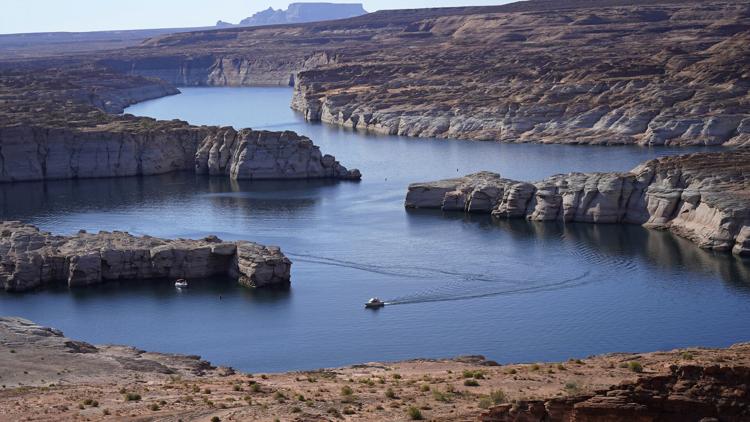
A boat cruises along Lake Powell near Page, Ariz., on July 31, 2021. Federal water officials have announced that they will keep hundreds of billions of gallons of Colorado River water inside Lake Powell instead of letting it flow downstream to southwestern states and Mexico. U.S. Assistant Secretary of Water and Science Tanya Trujillo said Tuesday, May 3, 2022, that the move would allow the Glen Canyon Dam to continue producing hydropower while officials strategize how to operate the dam with a lower water elevation.
Rick Bowmer / AP
(Cole Lauterbach) – Arizona’s water authorities are hinting that either Southern California’s governing water bodies or the group of upriver states along the Colorado River are responsible for talks breaking down between them, leaving the U.S. Bureau of Reclamation to announce the expected Tier 2 shortage and water allotment cuts falling more severely on State 48.
The federal agency announced Tuesday morning that allotments from the Glen Canyon Dam in Northern Arizona and the Hoover Dam near the Arizona-Nevada border would be decreased in 2023. The move was telegraphed when the bureau released its August report looking back over two years.
The announcement means Arizona faces a mandatory reduction of 592,000 acre-feet of water from the Colorado River in 2023, 21% of its annual allotment. Mexico will see a 104,000 acre-feet reduction, approximately 7% of the country’s annual allotment. Nevada’s river supply will be reduced by 8%, a reduction of 25,000 acre-feet.
As was the case for the Tier 1 shortage announcement this summer, California – home to the most senior water rights – will not see any reductions.
In a statement released Tuesday morning, the Arizona Department of Water Resources Director Tom Buschatzke and Central Arizona Project General Manager Ted Cooke said they and their counterparts in Nevada had brought strong plans to the table that would have eventually met the bureau’s hefty demand to reduce water usage by an additional 2-4 million acre-feet (MAF) but others in the basin weren’t interested.
“Arizona and Nevada put forward an aggressive proposal that would achieve 2 MAF of reductions among the Lower Basin and Mexico in 2023 and beyond. That proposal was rejected,” the statement said. “It is unacceptable for Arizona to continue to carry a disproportionate burden of reductions for the benefit of others who have not contributed.”
The Imperial Irrigation District, which uses most of California’s share of water to irrigate 474,000 acres of water-starved farmland in the southeastern portion of the state, didn’t respond to requests for comment.
The California Metropolitan Water District uses more than 1 million acre-feet of water to account for around half of its total usage. The agency told The Center Square that it’s committed to finding common ground.
“Metropolitan along with our California partners are committed to the continued efforts of collaboration and partnership to achieve voluntary water cuts that can respond to the changing climate and protect Lake Mead and Lake Powell,” General Manager Adel Hagekhalil said. “Every community within the basin should preserve every drop to help us all as ‘We are One.’” Hagekhalil added that the agency is partnering with Nevada and Arizona on water conservation efforts and building local water supply sources such as the Pure Water Southern California in Carson where 150 million gallons per day of wastewater is being purified to reduce consumption of river water.
The Colorado River begins in the Rocky Mountains and snakes nearly 1,500 miles south before anything not diverted empties out into the Mexican Gulf of California. Forty million people in the basin rely on the river, including residents in the upper basin that include Colorado, New Mexico, Utah, and Wyoming. The lower basin includes Arizona, Nevada and Southern California.
Sharon B. Megdal, director of the Water Resources Research Center at the University of Arizona, says there are no public details about negotiations between the states and Mexico so it’s unclear who rejected what and why.
“These negotiations are done behind closed doors and there is every effort to maintain that confidentiality,” she told The Center Square Tuesday. “The 2-4 million acre-foot water curtailment is an unprecedented ask, not only in size but in speed at which the states were asked to respond.”
Megdal noted the funds in the Inflation Reduction Act, which President Joe Biden signed Tuesday, could change the dynamic of negotiations between states.
By


Facebook
Twitter
Pinterest
RSS